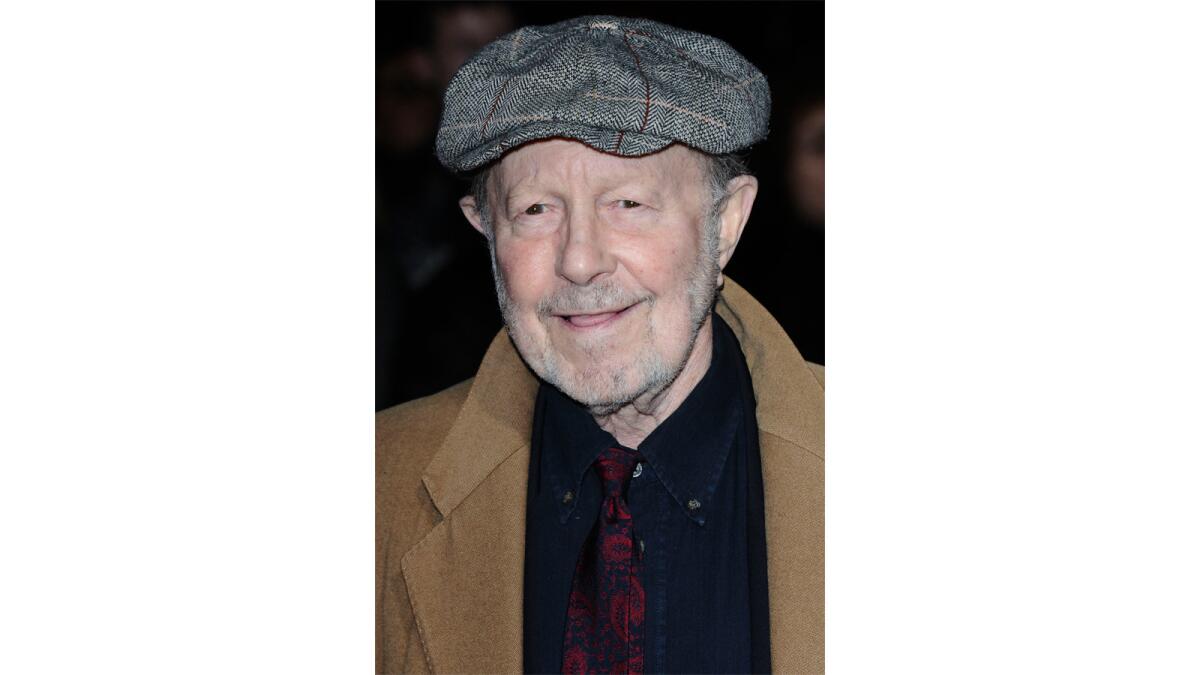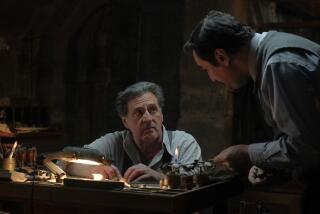Appreciation: Nicolas Roeg, director of ‘Don’t Look Now,’ was a darkly sensual poet of the screen
A pool of red spilling across a church altar. Two naked bodies writhing in intimate communion. Three figures making their way across a desert, dwarfed by the landscape behind them and the blazing sun above them. A woman peeling off her beautiful white mask to reveal the grotesque, worm-eaten visage within.
English director and cinematographer Nicolas Roeg, who died Friday at age 90, spent his career making brilliant, searing images, the kinds of images that burrow into your brain and take your memory captive. The stunning early run of pictures he directed in the 1970s — “Performance” (a collaboration with Donald Cammell), “Walkabout,” “Don’t Look Now” and “The Man Who Fell to Earth” — established Roeg as a great sensualist and a poet of the irrational, a filmmaker who could make the screen positively shudder with beauty, eroticism and danger.
It was not a career many might have imagined for a man who began his film career fetching tea for employees at London’s Marylebone Studios. He eventually became a clapper loader, or second assistant camera, and worked his way up the ladder from there. The credits he amassed during his first two decades or so behind the camera were impressive; he was a second unit cinematographer on David Lean’s “Lawrence of Arabia” (1962) and he later served as cinematographer on François Truffaut’s “Fahrenheit 451” (1966) and Richard Lester’s “Petulia” (1968).
“Petulia” was the last film Roeg shot before he turned his attention to directing, and that movie’s atmosphere of unease, as well as its French New Wave-influenced vocabulary of flashbacks and flash-forwards, clearly became aesthetic foundations of his own work. From his 1973 horror masterpiece, “Don’t Look Now,” to his twisty, flashback-laden 1980 thriller, “Bad Timing,” Roeg often delighted in stringing scenes and moments together in ways that defied conventional narrative logic, and not just for the sake of a showily nonlinear presentation. Few directors were as good at evoking a sense of the world being ruptured from within, or forcing their formal syntax to mirror the jagged, violent stories they were telling.

In “Don’t Look Now,” adapted from a Daphne du Maurier short story, Roeg gave us one of the cinema’s great erotic passages as well as some of its most indelible shocks. The movie’s signature images still have the power to astound: a lovemaking scene between Donald Sutherland and Julie Christie so intense and passionate that more than a few assumed it was unsimulated; a final-act reveal that will change the way you see Venice, raincoats and the color red forever.
The genius of the movie, however, lay in Roeg’s obsessive splintering of narrative, the way he employed jump cuts, cross-cutting and other editing techniques to build an intricately layered, densely expressive montage. Stranding his characters in a terrifying psychological and supernatural labyrinth of their own making, he spun their feelings of grief, desire and dread into a convulsive yet startlingly coherent visual language.
It wasn’t the first or last time Roeg would play so aggressively with form. In their sordidly arresting 1970 debut, “Performance,” conceived under the heady spell of Argentine writer Jorge Luis Borges, Roeg and Cammell turned an unclassifiable gangster drama into an early psycho-thriller experiment, a test of the ever-blurry boundaries separating reality and fantasy. They also had the inspiration to give Mick Jagger his screen acting debut — not the last time Roeg would turn a rock star’s persona to his advantage.
The most famous example of this, of course, was “The Man Who Fell to Earth” (1976), in which Roeg didn’t cast David Bowie as an alien so much as reveal the alien who was lurking there all along. An eccentric, melancholy speculative fiction that races, meanders and stumbles on deep reservoirs of emotion, the movie drank deeply from the well of Bowie’s singular screen presence, his sublime Otherness. He was the most alien of humans and vice versa.
It also confirmed that Roeg’s sense of beauty was never merely decorative or pictorial; he used his actors to brilliant effect, often by setting them in meaningful conflict with their surrounding environs. As a study of an individual adrift in a strange land, “The Man Who Fell to Earth” would make a sublime double bill with “Walkabout,” Roeg’s mesmerizing 1971 odyssey through the Australian Outback, which remains one of his most beautiful and affecting films.
Like his countryman Ken Russell, who died in 2011, Roeg was never afraid to push into areas of sexuality and violence that ran afoul of the censors. And like so many artists who pushed the expressive boundaries of the medium, he was often underappreciated by critics and audiences, and also by an industry that could seem indifferent at best and punitive at worst.
“British cinema has never much cared for its visionaries,” the Independent film critic Geoffrey Macnab astutely noted in 2011. And so it has been with Roeg, who is plenty revered now — his play with narrative and temporality has had an especially profound influence on filmmakers like Steven Soderbergh and Christopher Nolan — but who was increasingly banished to the margins of the industry as his career progressed. His later films were not without their pleasures and rewards, as latter-day admirers of “Eureka” (1983) and “Insignificance” (1985) can attest, but they failed to reclaim the sustained vitality of his ’70s heyday.
With one crucial exception. “The Witches” (1990), one of the last films Roeg directed, also happens to be the first of his films I ever saw, when I was a 7-year-old with a serious Roald Dahl addiction. Roeg was not what you’d describe as a director of films for children, and yet with this thrillingly macabre fantasy, he gave us both a sterling example of the form and a surprisingly effective introduction to his work.
Here could be found Roeg’s shivery skill with actors — Anjelica Huston’s Grand High Witch remains one of her crowning achievements — and also his superb eye, the impish wit with which he visualized the perverse and grotesque. Here too were all the sensations and emotions I still associate with so much of Roeg’s work even now: wonderment and surprise, terror and gratitude.
More to Read
Only good movies
Get the Indie Focus newsletter, Mark Olsen's weekly guide to the world of cinema.
You may occasionally receive promotional content from the Los Angeles Times.







